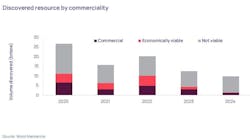OTC 2018: New technologies needed for ultra-high pressure reservoirs in Gulf of Mexico
Offshore staff
HOUSTON – Oil and gas production in the Gulf of Mexico is expected to reach record levels in 2018 and 2019, but production levels beyond that may begin to decline if ultra-high pressure reservoirs are not developed.
That analysis was offered by William Turner, Senior Research Analyst, Gulf of Mexico with Wood Mackenzie on Monday at the Offshore Technology Conference in Houston. Ultra-high pressure reservoirs are defined as having an operating pressure of up to 20,000 psi.
New “cutting-edge” technology will be needed for developing these ultra-high pressure reservoirs, but Turner noted that the industry is not there yet. Advances in well completion systems and high-integrity pressure protection systems will be needed to access these ultra-high-pressure reservoirs. “The technology is not quite there for 20,000 psi, but it should be there soon,” he said.
It is estimated that 2.3 Bboe are available in ultra-high pressure reservoirs, including deepwater fields such as Anchor, Tigris, Shenandoah, North Platte, and Kaskida. Turner noted the role of Chevron as a leader in ultra-high pressure reservoir development, and said that the company’s Anchor and Tigris fields “will pave the way.”
Turner said that there would be “up to four new floating production systems installed in the GoM over the next few years,” relating to ultra-high pressure reservoir development. Subsea tiebacks, while a useful, capex-friendly strategy for brownfield development, will not prevent the decline, he commented.
05/01/2018


